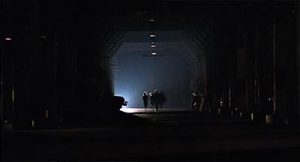Invasion of the Body Snatchers
Friday, October 5th, 2007 • Horrorthon Posts / Horrorthon Reviews
If I was going to do a Horrorthon “Masterpiece Edition” series this movie would definitely be in it. It’s simply one of the best there ever was. I wasn’t necessarily going to review this but ac made a comment on my Invasion review Tuesday, suggesting that there might be some interest in that movie’s vastly superior predecessor.
As I explained below, Invasion of the Body Snatchers (1978) is itself a remake of Invasion of the Body Snatchers (1956), which is based on Jack Finney’s novel The Body Snatchers (1955). (There’s a 1990’s film version that I have not yet seen.) When this 1978 version was released (and I saw it in the theater) I remember that all the reviews were discussing it as a “modernized,” “updated” version with questionable changes, much the same way I’m discussing the Kidman version below. (I doubt anyone would have predicted they’d still be making this movie another thirty years later.)
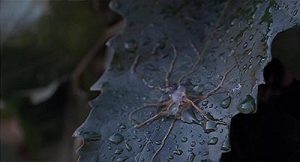
Alien symbiotes come down in the rain over the Bay Area
The “fidelity” of the ’78 remake was an issue at the time, mainly because Finney’s novel and the first movie are set in a small rural town, while the ’78 version moves the action to San Francisco. Small-town local doctor Miles Bennell (Kevin McCarthy) becomes San Francisco Department of Health investigator Matthew Bennell (Donald Sutherland). Despite these and other minor changes, however, the ’56 version and the ’78 version are remarkably similar. The alien morphology is identical; the plot moves are basically the same; the pacing and the scenes are essentially following the same pattern. (The ending is quite different.) It’s really the same story (unlike the Kidman version); what makes this an absolute masterpiece of horror, the definitive version of the tale (in my opinion) is the incredible skill and artistry and intelligence with which the story is told.
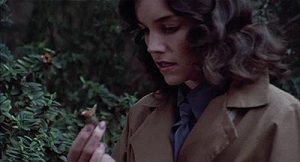
Brooke Adams finds a hybrid flower
As I mentioned on the phone to octopunk recently, I think the greatest movies in the genre are the hardest to review. That’s a general trend in the arts: how do you “review” The Great Gatsby or Mahler’s 4th symphony? What do you say when the work of art in question is part of what makes you (and the world) understand what a “novel” or a “symphony” is to begin with? Invasion of the Body Snatchers had a tremendous influence on me when I saw it in the theater, not just because it scared the living crap out of me for weeks to come but because it was part of my early understanding of the art of movies and what movies could do. I was tremendously fortunate to grow up in the ‘Seventies because the movies of my childhood have pretty much all emerged as bona fide classics, thirty years later. It’s great when your period of greatest nostalgia turns out to be a “golden age” culturally in that way. But enough about me! What makes Invasion of the Body Snatchers so good? I’ll go through it categorically:
1) Phillip Kaufman
One of the legendary USC directors (along with Lucas and Coppola), Philip Kaufman worked in close harmony with Lucasfilm (he gets a story credit on Raiders because of a single, intense conversation he had with Lucas) and the rest of that gang. Kaufman went on to do The Right Stuff and Naked Lunch and other interesting movies, and his deft visual touch and skill with actors is almost definitely the reason that Body Snatchers is so damn good. Specifically, Kaufman brought in Ben Burtt (Oscar-winning sound maestro for the Star Wars trilogy) to handle the sophisticated audio effects in this movie. Additionally he got Michael Chapman (Taxi Driver; Raging Bull; The Fugitive) to shoot the movie and encouraged Chapman to use an innovative palette of photographic techniques, in order to properly set the tone of the piece. The first half-hour of Body Snatchers could be shown to any Hitchcock-loving film class as an example of how to build tension with photography and sound even when very little is happening. (If anyone rents the movie, it’s worth listening to Kaufman’s commentary track at some point, because he goes into great detail about all of this.)
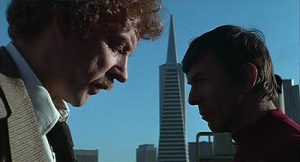
Donald Sutherland and Leonard Nimoy
2) ‘Seventies Actors
Donald Sutherland, Brooke Adams, Jeff Goldblum, Veronica Cartwright, and Leonard Nimoy are the epitome of the 1970s ensemble cast, each turning in compelling naturalistic performances (like you’d see in a Woody Allen movie) and additionally providing a sense of community and friendship that’s perfect for the subject matter of this movie. As I described in the other review, the pod takeover is stealthy and gradual, depending on the pods believably passing for humans while their numbers increase over the crucial first few days of the invasion. There could be no better device for conveying this than a realistically-depicted and likable group of sophisticated, reasonably funky San Francisco professionals in their ‘thirties and ‘forties. Early scenes between Health Inspectors Sutherland and Adams, poet/bathhouse owner Goldblum, celebrity-shrink Nimoy and Goldblum’s granola-crunchy wife Cartwright could have come out of any of the superior ’70s movies about smart, beleaguered urban professionals. (The fact that Nimoy and Goldblum can’t stand each other makes for some great business between them.) Realism is crucial in tales of the fantastic, and the actors in this movie deliver such nuanced performances that when they begin to go down one by one (as you know is coming) the results are terrifying and heartbreaking. (The same remarks can be made, perhaps most fittingly, about Alien, which is the ultimate example of how much horror benefits from good actors. I’ve never been able to deal with Aliens because going from the likes of John Hurt and Ian Holm to the likes of Michael Bien and Bill Paxton is such a tremendous letdown; from Royal Shakespeare Company horror to TNT original movie horror.) Most importantly, the themes of the story—the value of human frailties and emotions in the face of growing alienation and fear and conformity—are brought into vivid relief by the performances.
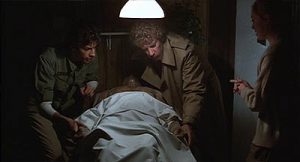
Jeff Goldblum, Donald Sutherland and Veronica Cartwright
examine a partially-formed pod
3) What it All Means
Like I said up top, when genre movies are this good it’s difficult to review them in a conventional sense, because they “transcend the genre” (as is often said) and reach heights of expression and meaning that confound the usual templates for judgment. Movies like The Godfather and The Matrix are good enough that you stop thinking in terms of the specific limitations of “mob crime movie,” “sci-fi adventure” because those constraints are suddenly gone and the essence of what makes the genre compelling in the first place is laid bare in a new way. Invasion of the Body Snatchers (complete with lurid 1950s title) succeeds in precisely this way: it’s the same story as the other Body Snatchers movies, but it’s just so well done, so soulful, so intelligent, so gripping that you find it resonating in your head for a while after you’ve seen it. (This part may be nostalgia: I encourage Horrorthoners to watch this movie and let me know if I’m getting it right.) Stephen King wrote (in his excellent book-length essay on horror, Danse Macabre) that horror stories are crucial because they allow an unflinching look at our own deep psyches; our irrationality; our terror of mortality; our sensations of powerlessness or loss of control in a hostile world. Do you want all your fears to go away? Or do you want to stay who you are: a vulnerable and confused person in a hostile but beautiful world? If you choose the second option, then just remember: don’t fall asleep.
